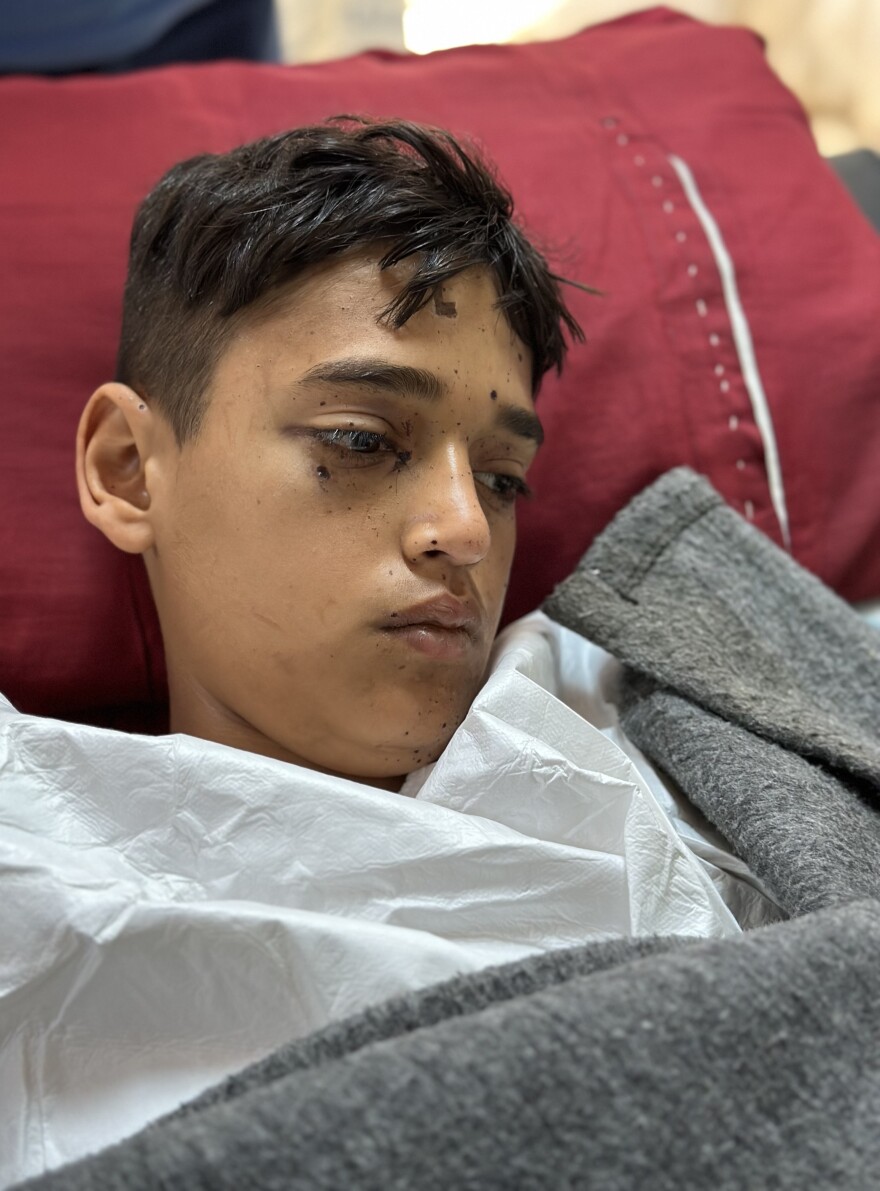KHAN YOUNIS, Gaza Strip and TEL AVIV, Israel — When the Abu Samur family returned to their neighborhood of southern Gaza last month, after Israeli troops withdrew from the immediate area, they found their house mostly destroyed. Only the bathroom was intact.
That's where 14-year-old Mohammed Abu Samur — always curious, exploring, investigating — found what he says he thought was a bottle of perfume or deodorant.
It was black, metal, like an aerosol can. His father Yasser Abu Samur, 48, thought it looked suspicious, and told his son to throw it away, the father recalls. But it was too late.
"It exploded on me. It exploded on me and my siblings," Mohammed, wrapped in bandages, told NPR in an interview this month from his gurney at the European Hospital in Khan Younis.
As Palestinians like the Abu Samur family venture back into areas of Gaza that have been obliterated by months of combat, international organizations and aid groups say there's a hidden threat: unexploded ordnance.
The rule of thumb, explosives experts say, is that 10% of munitions do not detonate on impact. That means an estimated 7,500 metric tons of live munition may be scattered throughout the Gaza Strip, according to the United Nations.
"It's everything from mortars, artillery shells and grenades to improvised rockets and bombs and missiles," says Mungo Birch, head of the U.N. Mine Action Service (UNMAS) in the Palestinian territories. "One of the most dangerous times is when people return home."
These weapons could continue to kill and maim Palestinians even if a cease-fire eventually ends the Israel-Hamas war. The U.N. estimates it could take 14 years to make Gaza safe from these bombs.
Unexploded ordnance has long been a danger in Gaza

When Hamas-led militants attacked Israel on Oct. 7, Birch happened to already be in Gaza. He was working on clearing unexploded ordnance left over from a 2021 conflict there.
Munitions have been left by both Hamas and Israel, he says. Much of it is hidden in what the U.N. estimates is 37 million metric tons of debris.
"There's now more rubble in Gaza than there is in Ukraine," Birch says. "And to put that in perspective, the front line in Ukraine is about 600 miles and Gaza is 25 miles long."
When a U.N. team inspected Khan Younis, the area where the Abu Samur family lives, they said they found 1,000-pound bombs, unexploded, in main intersections and inside schools.
"I was in Sarajevo in '92, I was in Baghdad in 2003, I was in Kabul. But nothing can compare to what we saw in Gaza," says Erik Tollefsen, an explosives expert who served in the Norwegian military and is now with the International Committee of the Red Cross (ICRC). He was in Gaza in February and March.
"It's just breathtaking, the level of destruction. It's really horrifying," he says.
Tollefsen found an unexploded artillery shell just 6 feet from the door of the ICRC office in Gaza City, he says. One day, while driving past a camp for displaced Palestinians, he spotted a tent pegged with an unexploded missile. Children were playing around it, he recalls.
Normally, to get rid of explosives, you actually need more explosives — to set off a controlled detonation. But explosives are not on the list of materials Israel currently allows aid workers to carry into Gaza.
So Tollefsen brings his own climbing gear and fishing hooks. He uses them to gingerly drag bombs away from people's tents. But without heavy equipment, he can't dispose of the bombs.
"We just have to leave them there," he says. "I find that quite disturbing, that we can't help them any other way."
Aid workers are mapping the location of dangerous munitions and sending out warnings on social media. But with electricity scarce and 4G connectivity limited in Gaza right now, they're also posting stickers and circulating leaflets.
"Children are very curious. They see with their hands. They touch things," Tollefsen notes. "That makes them extremely vulnerable."
What happened to 14-year-old Mohammed Abu Samur

When what he thought was a perfume bottle exploded, Mohammed lost his left hand below the elbow, and all the fingers on his right hand. It took four doctors and seven hours of surgery to salvage his legs.
But they say he may still lose them to infection, in Gaza's collapsed health system.
When NPR visited Mohammed's hospital bedside, in early May, his wounds hadn't been cleaned in several days. Flies swarmed around his face, pockmarked by shrapnel. His bandages had turned yellow and green.
Weapons experts tell NPR that the black metal canister Mohammed thought was perfume or deodorant was probably the fuse for an anti-tank mine — possibly a model made in the U.S. Israel uses them to demolish what it says are buildings and tunnels used by Hamas.
Some of those fuses have also been mistaken for canned food, as famine spreads across Gaza.
Speaking on condition of anonymity, in line with government protocol, an Israeli military spokesperson told NPR that soldiers do take munitions off the battlefield with them when they withdraw, "where it is feasible."
But experts say so much remains behind, and many more curious youngsters like Mohammed are likely to pay the price for this war.
Frayer reported from Tel Aviv, and Baba reported from Khan Younis and Rafah City.
Copyright 2024 NPR




